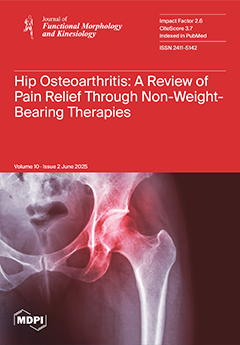Background: To achieve victory, kayaking and rowing athletes must develop optimal aerobic conditioning and the capacity to sustain anaerobic work production. To assess these characteristics, power output (PO), lactatemia response, and maximum oxygen uptake (VO
2max) are usually measured. The goal of
[...] Read more.
Background: To achieve victory, kayaking and rowing athletes must develop optimal aerobic conditioning and the capacity to sustain anaerobic work production. To assess these characteristics, power output (PO), lactatemia response, and maximum oxygen uptake (VO
2max) are usually measured. The goal of this research is to report the values of PO, lactatemia, and VO
2max—expressed in relative, absolute, and body size-scaled values—in successful international-level athletes to provide reference values for those striving to compete at the highest level. Methods: A total of 15 international-level medallist boat sports athletes were recruited: 8 male kayakers (age 21 ± 3 years, height 181.7 ± 5.3 cm, body mass 78.7 ± 5.6 kg), 2 female kayakers (age 22 ± 2 years, height 168.0 ± 2.8 cm, body mass 64.9 ± 2.7 kg), and 5 male rowers (age 20 ± 1 years, height 181.9 ± 4.7 cm, body mass 83.9 ± 7.3 kg). The athletes’ PO, lactatemia, and VO
2max were assessed using an off-water, sport-specific cardiopulmonary test on a paddle and rowing ergometer. Results: Respectively, in male and female kayakers and male rowers, maximum lactatemia was 11.9 ± 2.2 mmol/L, 9.3 ± 3.6 mmol/L, and 13.2 ± 3.7 mmol/L; maximum PO was 225.0 ± 13.4 W, 162.5 ± 31.8 W and 432.0 ± 33.5 W; and VO
2max was 57.6 ± 5.4 mL/min/kg, 52.2 ± 1.0 mL/min/kg, and 63.7 ± 11.7 mL/min/kg. VO
2max scaled by body size was, respectively, 311 ± 39 mL/kg
0.67/min, 319 ± 15 mL/kg
0.67/min, and 330 ± 72 mL/kg
0.67/min. Conclusions: This study is the first to report the values of PO, lactatemia, and VO
2max—expressed in relative, absolute, and body size-scaled values—assessed during a sport-specific cardiopulmonary test in international-level boat sports athletes. These values could be a preliminary reference guideline for optimal cardiorespiratory conditioning in athletes aiming at international-level competitions.
Full article






